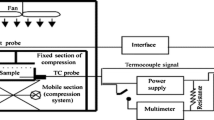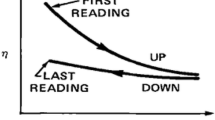Abstract
The effects of NaCl and osmotic dehydration on the linear viscoelastic behavior of duck egg yolk were evaluated. An increase in NaCl concentrations from 0% to 3.0% (w/w) resulted in a remarkable change in the linear viscoelastic behavior by inducing a sol–gel transition, specifically. The transition was more pronounced when 1.5% (w/w) NaCl was incorporated. The effect of dehydration on aggregation and network formation was predominant than that of the NaCl addition. Nevertheless, at a lower degree of dehydration, the addition of NaCl could modulate the viscoelastic behavior of duck egg yolk, resulting in a well-developed gel network. Addition of NaCl into duck egg yolk could stabilize the protein molecules as evidenced by an increase in denaturation temperature as well as a delay in gel network formation. As visualized by a scanning electron microscope, the denser network with smaller voids was observed in duck egg yolk gel with increasing NaCl concentration and degree of dehydration.







Similar content being viewed by others
References
Abdel-Nour, N., Ngadi, M., Prasher, S., & Karimi, Y. (2011). Prediction of egg freshness and albumen quality using visible/near infrared spectroscopy. Food and Bioprocess Technology, 4, 731–736.
Aguilar, J. A., Cordobes, E., Jerez, A., & Guerrero, A. (2007). Influence of high pressure processing on the linear viscoelastic properties of egg yolk dispersions. Rheologica Acta, 46, 731–740.
Anton, M., & Gandemer, G. (1997). Composition, solubility and emulsifying properties of granules and plasma of egg yolk. Journal of Food Science, 62, 484–487.
Anton, M., Le Denmat, M., Beaumal, V., & Pilet, P. (2001). Filler effects of oil droplets on the rheology of heat-set emulsion gels prepared with egg yolk and egg yolk fractions. Food Hydrocolloids, 21, 137–147.
Anton, M., Martinet, V., Dalgalarrondo, M., Beaumal, V., David-Briand, E., & Rabesona, H. (2003). Chemical and structural characterization of low-density lipoproteins purified from hen egg yolk. Food Chemistry, 83, 175–183.
Burley, R. W., & Cook, W. H. (1961). Isolation and composition of avian egg yolk granules and their constituents alpha- and beta lipovitelins. Biochemistry and Cell Biology, 39, 1295–1307.
Causeret, D., Matringe, E., & Lorient, D. (1991). Ionic strength and pH effects on composition and microstructure of yolk granules. Journal of Food Science, 56, 1532–1536.
Chang, C. M., Powrie, W. D., & Fennema, O. (1977). Microstructure of egg yolk. Journal of Food Science, 42, 1193–1200.
Chi, S. P., & Tseng, K. H. (1998). Physicochemical properties of salted pickled yolk from duck and chicken eggs. Journal of Food Science, 63, 27–30.
Clark, A. H. (1998). Gelation of globular proteins. In S. E. Hill, D. A. Ledward, & J. R. Mitchell (Eds.), Functional Properties of Food Macromolecules (pp. 77–142). Gaithersburg: Aspen.
Cordobes, F., Partal, P., & Guerrero, A. (2004). Rheology and microstructure of heat induced egg yolk gels. Rheologica Acta, 43, 184–195.
Damodaran, S., & Kinsella, J. E. (1982). Effects of ions on protein conformation and functionality. Food Protein Deterioration, 206, 327–351.
Danilenko, A., Rogova, E., Bikbov, T., Gringerg, V. T., & Tolsotoguzov, V. (1985). Stability of 11S globulin from vicia faba seeds. Studies using differential scanning microcalorimetry. International Journal of Peptide and Protein Research, 26, 5–12.
Foegeding, E. A., Davis, J. P., Doucet, D., & McGuffey, M. K. (2001). Advances in modifying and understanding whey protein functionality. Trends in Food Science and Technology, 13, 151–159.
Guerrero, A., Carmona, J., Martinez, I., Cordobes, F., & Partal, P. (2004). Effect of pH and added electrolyte on the thermal-induced transitions of egg yolk. Rheologica Acta, 43, 539–549.
Harrison, L. J., & Cunningham, F. E. (1986). Influence of frozen storage time on properties of salted yolk and its functionality in mayonnaise. Journal of Food Quality, 9, 167–174.
Hsu, K. C., Chung, W. H., & Lai, K. M. (2009). Histological structures of native and cooked yolks from duck egg observed by SEM and cryo-SEM. Journal of Agricultural and Food Chemistry, 57, 4218–4223.
Kaewmanee, T., Benjakul, S., & Visessanguan, W. (2009a). Changes in chemical composition, physical properties and microstructure of duck egg as influenced by salting. Food Chemistry, 112, 560–569.
Kaewmanee, T., Benjakul, S., & Visessanguan, W. (2009b). Effect of salting processes on chemical composition, textural properties and microstructure of duck egg. Journal of Agricultural and Food Chemistry, 89, 625–633.
Kaewmanee, T., Benjakul, S., & Visessanguan, W. (2011). Effect of acetic acid and commercial protease pretreatment on salting and characteristics of salted duck egg. Food and Bioprocess Technology. doi:10.1007/s11947-011-0510-1.
Kiosseoglou, V. (2003). Egg yolk protein gels and emulsions. Current Opinion in Colloid and Interface Science, 8, 365–370.
Kiosseoglou, V., & Paraskevopoulou, A. (2005). Molecular interactions in gels prepared with egg yolk and its fractions. Food Hydrocolloids, 19, 527–532.
Kiosseoglou, V. D., & Sherman, P. (1983). The influence of egg yolk lipoproteins on the rheology and stability of O/W emulsions and mayonnaise. Colloid and Polymer Science, 261, 502–507.
Lai, K. M., Chuang, Y. S., Chou, Y. C., Hsu, Y. C., Cheng, Y. C., Shi, C. Y., et al. (2010). Changes in physicochemical properties of egg white and yolk proteins from duck shell eggs due to hydrostatic pressure treatment. Poultry Science, 89, 729–737.
Le Denmat, M., Anton, M., & Gandemer, G. (1999). Protein denaturation and emulsifying properties of plasma and granules of egg yolk as related to heat treatment. Journal of Food Science, 64, 194–197.
Martin, W. G., Augustyniak, J., & Cook, W. H. (1964). Fractionation and characterization of the low-density lipoproteins of hen’s egg yolk. Biochimica et Biophysica Acta (BBA), 84, 714–720.
Martinez, I., Riscardo, M. A., & Franco, J. M. (2007). Effect of salt content on the rheological properties of salad dressing-type emulsions stabilized by emulsifier blends. Journal of Food Engineering, 80, 1272–1281.
Mine, Y. (2007). Structure and chemical composition of eggs. In E. C. Y. Li-Chan & H. O. Kim (Eds.), Egg Bioscience and Biotechnology (p. 15). Hoboken: John Wiley & Sons.
Puppo, M. C., & Anon, M. C. (1998). Structural properties of heat-induced soy protein gels as affected by ionic strength and pH. Journal of Agricultural and Food Chemistry, 46, 3583–3589.
Puppo, M. C., & Anon, M. C. (1999). Soybean protein dispersions at acid pH: thermal and rheological properties. Journal of Food Science, 64, 50–56.
Sanchez, C., & Burgos, J. (1997). Gelation of sunflower globulin hydrolysates: rheological and calorimetric studies. Journal of Agricultural and Food Chemistry, 45, 2407–2412.
Shenstone, F. S. (1968). The gross composition, chemistry and physic-chemical basis of organization of the yolk and white. In T. C. Carter (Ed.), Egg quality: a study of the hen’s egg (pp. 26–66). Edinburgh: Oliver and Boyd.
Standing, M., Langton, M., & Hermansson, A. M. (1995). Small and large deformation studies of protein gels. Journal of Rheology, 39, 1445–1450.
Steel, R. D., & Torrie, J. H. (1980). Principle and procedures of statistic: a biometrical approach (2nd ed.). New York: McGraw-Hill.
Ternes, W. (1989). Characterization of water soluble egg yolk proteins with isoelectric focusing. Journal of Food Science, 54, 764–765.
USDA (2010) NDB No 01123 & 01138. National Nutrient Database for Standard Reference, Washington DC, USA. Available at: www.ars.usda.gov/nutriendata. Accessed 23 June 2011.
Wang, C. T. (1991). The physical-chemical properties of salted egg yolk during granulation or gelation process. Journal of the Chinese Agricultural Chemistry Society, 29, 406–414.
Wang, C. T. (1992). Manufacture of salted hen yolk from fresh hen yolk. Journal of the Chinese Society of Animal Science, 21, 429–440.
Woodward, S. A., & Cotterill, O. J. (2006). Texture and microstructure of cooked whole egg and heat-formed gels of stirred egg yolk. Journal of Food Science, 52, 63–67.
Acknowledgment
The authors would like to express their sincere thanks to Prince of Songkla University and National Research Council of Thailand for the financial support.
Author information
Authors and Affiliations
Corresponding author
Rights and permissions
About this article
Cite this article
Kaewmanee, T., Benjakul, S., Visessanguan, W. et al. Effect of Sodium Chloride and Osmotic Dehydration on Viscoelastic Properties and Thermal-Induced Transitions of Duck Egg Yolk. Food Bioprocess Technol 6, 367–376 (2013). https://doi.org/10.1007/s11947-011-0667-7
Received:
Accepted:
Published:
Issue Date:
DOI: https://doi.org/10.1007/s11947-011-0667-7




